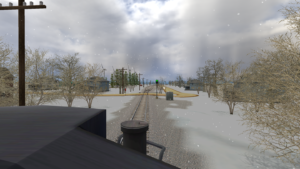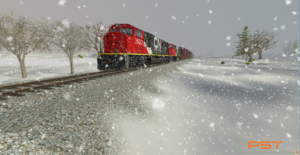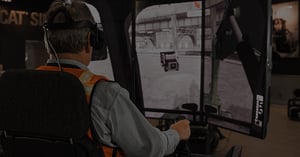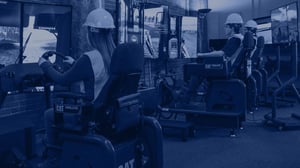Locomotive training cues for train engineers
When PS Technology observed that haptic simulated training was successful in other similar industries such as construction and heavy equipment, they saw an opportunity to leverage this insight and bring this technology to the rail industry with the UP FIT solution.
Created to help train engineers familiarize themselves with specific rails through simulated scenarios, the UP FIT solution was built with a D-BOX MFX 130 seat to provide the trainees with three degrees of freedom while training: roll, pitch, heave and vibrations.
On top of these degrees, two customized cues were created in-house to make the solution as realistic as possible: frog bump and coupler impact. Frog bump allows the engineers to feel the sensation that occurs when connecting rails cross over one another while coupler impact is the sensation that occurs when connected wagons hit one another as the train is braking or stopping. More customized cues are also in the works, such as the feeling of the train hitting bumps at road crossings.
With haptic technology’s proven success in other industries, PS Technology believes that the increased immersion offered by the UP FIT solution is helping to prepare the rail industry (and its regulatory agencies) for fully accepted route training and refamiliarization check-rides, which would save companies a significant amount of money without sacrificing safety or efficiency.

Increase recruitment of train engineers
Introducing the UP FIT solution to the market now is critical, per PS Technology. As the currently employed demographic in the rail industry is aging, employers are looking for ways to bring up recruitment numbers rapidly and efficiently; allowing them to prepare the next generation of train engineers to safely take over operations when the time comes.
For recruitment purposes, the UP FIT haptic training solution is also an excellent tool to help combat the current labour shortage: companies can onboard quickly and efficiently while gaining more flexibility overall: they’ll be able to cross-train engineers on different rail types to have a well-trained, well-rounded, and more efficient workforce going forward.
Not only will companies be able to train employees more quickly, but training with haptic feedback is proven to be perceived as more serious by students – leading to an increased training participation and a more effective training transfer.
Ultimately, the UP FIT solution will allow train engineers to be trained efficiently on a more flexible & adaptable training curriculum than the current model will allow for.

A locomotive training solution with proven benefits for engineers
When trainees are training on the UP FIT solution fitted with a D-BOX haptic motion seat, they get many benefits that they wouldn’t have gotten without it.
For starters, train engineers are totally and completely immersed in the exercise and experience true-to-life sensations, especially with PS Technology’s in-house customized training cues allowing them to feel movements previously only felt on real rail. These sensations create all the conditions necessary for optimal training transfer: research proves that realistic haptic feedback in training solutions results in an enhanced feeling of calmness, enhanced memory recall and more efficient learning.
By training with realistic sensations from the get-go such as starts & stops and distributing power over rolling terrain, train engineers become acclimated to these expected sensations, making the rail industry safer for all – the ability to train with true-to-life sensations in a realistic training curriculum means that if an emergency were to occur on the rails, everyone aboard the train (and the materials the train carries) will be safer as a result of the staff’s preparedness.

Simulated training for a more efficient workforce
Given the success other industries have seen with haptic simulated training, it is only natural that more industries begin to turn to haptic technology when looking to re-invent the way they train their employees.
With an aging demographic currently riding the rails and the possibility for a more flexible, rapid, efficient and cost-effective training curriculum that makes the rails safer for everyone involved, it is only a matter of time before regulatory agencies embrace this innovative way to train and revolutionize the rail industry.







